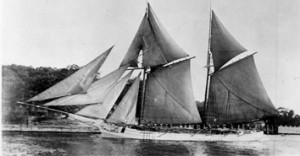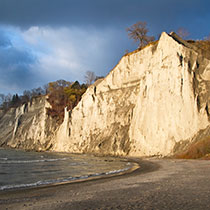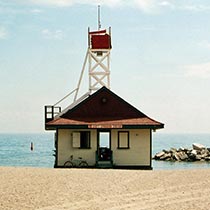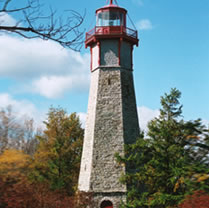 The Lyman M. Davis, Muskegan piers, 1906 Newaygo County Historical Archives, Miscellaneous Photos, no. 47
The Lyman M. Davis, Muskegan piers, 1906 Newaygo County Historical Archives, Miscellaneous Photos, no. 47
In our high speed, digital age, it is hard for many Torontonians to imagine a time, not so long ago, when Lake Ontario was our life line to the outside world.
Shortly after the arrival of Lieutenant Governor Simcoe in the Bay of Toronto in 1793, overland routes to more established centres at present day Kingston and Niagara were hacked out of the bush, though in the early years, these roads remained primitive and in a perennial state of disrepair. Prior to the advent of the railways in the mid-nineteenth century, residents of York, and later Toronto, relied heavily on the Lake for communication, transportation, and trade.
The most predominant vessel to ply the Great Lakes during this early period of settlement was the schooner, a wooden sailing ship with sails rigged parallel to the keel and with at least two masts. Many of these tall ships were specially adapted for Lake navigation through the use of a centreboard that allowed more resistance in the water, and the use of a distinctive triangular topsail known as a rafie.
Commercial schooners transported people and pioneer goods and produce from York and the surrounding districts to ports east and west along the shore, as well as across the Lake. These ships returned with cargoes of sugar, salt and other necessities, and carried critical communications between isolated pockets of settlement.
Many residents at or near the Toronto shore built their own vessels during these early years, and did a tidy export business of their own. Their vessels, often more compact and with flatter bottoms than typical commercial schooners, were able to put in at the mouths of the many creeks and rivers along the shore, from the Rouge River in the east, to Etobicoke Creek in the west, and points farther afield.
Let us also not forget the many individuals and local families, including the Wards of Toronto Island, the Langs of Woodbine Beach, “Old Portwine” of the Rouge, the Bonars of Mimico, and the Joyces of Port Credit, who were part of a small commercial fishing industry in the vicinity of Toronto. Some of these families continued to fish locally until well into the first half of the twentieth century.
Many other families, including the Goldrings, whose roots can be traced to the mouths of Mimico and Etobicoke Creeks, were involved in the stonehooking trade. During the nineteenth and early twentieth century, millions of tons of rock and gravel were pried from the shore and near shore waters of the Toronto region, hauled onto sailing ships, and used in the construction and foundations of what are now some of Toronto’s oldest buildings.
Our reliance on the Lake began to diminish with the advent of the railway era in the mid-nineteenth century. Improved year round road access made overland travel increasingly possible between formerly isolated settlements along the shore and in the hinterlands north of Lake Ontario. Lake based trade, transportation, and communication continued, though steam powered ships were increasingly favoured over schooners for their speed and reliability.
The Lyman M. Davis, built in Muskegan, Michigan in 1873, is considered by many to have been the last of the indigenous working commercial sailing vessels left on the Great Lakes. Though not a Toronto ship, in her later years the Davis had sailed out of Napanee and Kingston, hauling coal from Oswego, New York State to Canadian ports on the lower lakes until the early 1930s.
Still a strong and reliable servant, she was acquired by the proprietors of Toronto’s Sunnyside Amusement Park in 1933. Their intention was to destroy her as a grand public spectacle. Though another schooner, the Julia B. Merrill, and several other Island ferries had already suffered a similar fate, some city residents fought to save her, in large measure because she was the last, or very near the last of her kind.
The movement to save the Lyman M. Davis was led by marine historian, artist, and editor of the Evening Telegram, C.H.J. Snider, who will be the subject of an upcoming blog.
Great Lakes schoonerman Captain John Williams of the Beach also joined in the fight, and was quoted in the Evening Telegram on February 1, 1934, “Burning that old schooner would be an act of savagery… It would be on par with tying cans to the tail of some faithful old dog that had outlived its usefulness, and kicking him out on the street just to see how fast he would run.”
Public efforts to save the ship were ultimately in vain. According to the Evening Telegram, just before midnight, on June 29, 1934, the Lyman M. Davis was towed from the Sunnyside anchorage to about 300 yards beyond the sea wall. There she was blown up and burned to the glee of thousands of thrilled onlookers. She was then towed out to deep water, where a further blasting sent her tortured remains to the bottom of the Lake.
The bones of the Lyman M. Davis are out there still, just beyond Sunnyside Beach. With her lie the remnants of this City’s forgotten waterfront and marine heritage ― waiting to be rediscovered.
© Jane Fairburn, 2012
For more on the Lyman M. Davis, see:
Hunter, Douglas. “An Undefiled Heritage”, GAM on Yachting, February, 1983.
Palmer, Richard. “The Lyman M. Davis ― Last of the Great Lake Schooners”
<http://freepages.genealogy.rootsweb.ancestry.com/~twigs2000/palmdavis.html>








{ 7 comments… read them below or add one }
I totally agree with Captain Williams. To destroy a ship like the Lyman M. Davis, for a Saturdays entertainment was horrific. I am appalled by how many wanted to see the destruction. Very unattractive. Keep telling the stories. I want to know more about the events on the waterfront that have shaped this city and made us who we are. j
Fascinating reading. Thanks!
Thanks Erin. When you have a chance, check out the video of the dive to the Lyman M. Davis, see March 19/12 blog. It’s incredible how much of the ship remains to be seen! Jane
How tragic to destroy such an important part of our history. The video was mesmerizing. Keep the blog posts coming!! Love the site. Congratulations.
I am interested in finding all of the available photographs of the Lyman M. Davis when it was at Toronto 1933-1934. Do you have any idea how I might go about that?
John
Hi John,
A good starting point is the City of Toronto Archives. The archives holds some images of the Davis, though few, if any of them are digitalized. You can do an advanced search of the City archives online, but you’ll then have to go down to 255 Spadina Avenue and order up the boxes to see the images. You may have noticed that I have included a post card of the Lyman M. Davis held at the city archives in Along the Shore: Rediscovering Toronto’s Waterfront Heritage, (p. 364), as well as an image of the wreck as it appears in Toronto Bay today, (p. 365).
The articles of C.H.J. Snider in the Evening Telegram also included some interesting shots of the vessel — the Toronto Reference Library has all the back issues of the Telegram if you’re interested in taking a look — (they’re not online).
The Marine Museum of the Great Lakes in Kingston is a wonderful source of information on sailing ships, and they would also be worth a try. One other source may possibly be the Snider Fonds at the Archives of Ontario: http://ao.minisisinc.com/scripts/mwimain.dll/144/PROV/PROV/REFD+F+1194?SESSIONSEARCH. C.H.J. Snider was took up the cause of saving the ship, and there just may be a jewel or two lurking in this collection… good luck with your search and please let me know how it goes!
Jane
Dear John,
I have been collecting Lyman M. Davis photos for many years.
I have known and interviewed some of her crew.
I was the first diver to have discovered the wreck of the Davis and was the first to have seen her.
I created “Save Ontario Shipwrecks”.